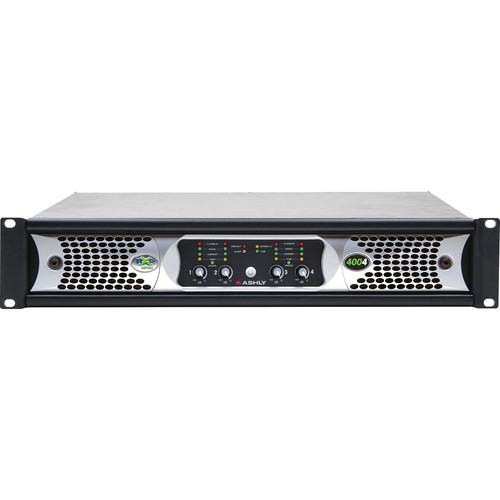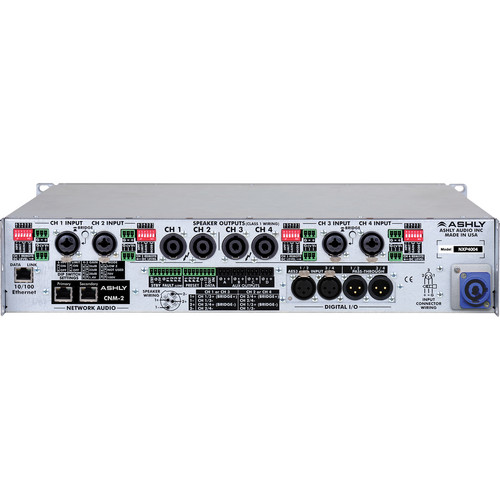EAN: 694970573819
The nXp Series NXP4004 4-Channel 400W Power Amplifier with Programmable Outputs & Protea Software Suite from Ashly is a Class-D switching amplifier combined with a switch mode power supply. This amplifier meets the requirements of demanding live sound and fixed installation sound systems in stadiums, arenas, performance venues, worship spaces, and convention centers.
This amplifier features the Protea DSP processing for efficient control. The rear panel has DIP switches for programming each channel output for either High-Z or Low-Z operation. This amplifier can be connected to a network with Ethernet control and features serial data control, aux preamp outputs, instant standby mode, preset recall, fault condition logic outputs, and optional network audio and digital audio capability, all controlled using the included Protea Software Suite.
The amplifier offers 32-bit SHARC DSP processing (with 48 & 96 kHz sampling) for comprehensive audio processing and built-in signal generator for test tone and noise-masking. It also offers swept load impedance monitoring on each amplifier channel output.
4-Channel high-output amplifier with programmable output on each channel (High-Z or Low-Z, selected via rear panel DIP switches)
Power-saving, Energy Management System with automatic <1W sleep-mode (defeatable)
Front panel power switch and level controls (can be disabled for security)
Rear panel DIP switches per channel for selection of high pass filter, limiter, input gain, and High-Z or Low-Z speaker output configuration
Remote DC level control on each input channel
Switch mode power supply automatically detects 120 or 240VAC operation
Extensive protection circuitry and continuously variable cooling fans
Multiple independent internal power supplies provide increased channel separation and reliability
Ethernet port for control and monitoring of amplifier functions, with front panel COM activity LED
Serial data port for use with Ashly remote control devices, or optional RS-232 converter for third party controllers (not included)
Use Protea software to remotely disable all front panel controls, including the on/ off switch, for a tamper-proof installation
Offers 32-bit SHARC DSP processing with 48 & 96 kHz sampling
Built-in signal generator for test tone and noise-masking
Swept load impedance monitoring available on each amplifier channel output
Real-time clock with event scheduler
Instant standby mode that can be triggered by contact closure, software control, or event scheduler for reduced power consumption
Programmable power-on delay
Preset recall via contact closure, software control, remote control, or event scheduler
Aux preamp outputs, and fault condition logic outputs
Optional Cobranet or Dante network audio and AES3 digital audio input with pass-through
Dynamics, gain, equalization, FIR filter ready, 2 x 4 or 4 x 4 matrix mixer, crossover, delay, metering, and signal generator functions for test and noise masking applications
Precision swept load impedance monitoring of each amplifier channel for quick and easy diagnosis of sound system problems remotely via Ethernet
Neutrik Combo XLR - 1/4 TRS jack plus Euroblock input connectors
Neutrik speakON twist locking loudspeaker connectors for security, safety, and reliability
Neutrik powerCON detachable AC mains connector
Made in USA
Ashly NXP4004 Specs
Processor
| Input Source | Protea DSP Options: Analog, auto (net, AES3, analog) |
| Limiter | Brick Wall Limiter: Threshold: -20 to 20 dBu Ratio: Infinite Attack: 0.2 to 50 ms/dB Release: 5 to 1000 ms/dB |
| Control | Advanced Gate Controls Key Engage Enable Key Frequency: 20 Hz to 20 kHz Key Bandwidth: 0.016 to 3.995 octave |
| Gain | Gain (with / without VCA): -50 to 12 dB, off, polarity invert Digital VCA Groups: 4 available Remote RD8C Gain: Enable per channel, 0 dB to -₧ WR-5 (neWR-5) Remote Gain: 0 to -50 dB, mute |
| EQ Type | For 31-Band Filter Type: Constant Q or proportional Bandwidth: 0.499 octave to 0.25 octave For Parametric 2,4,6, or 10 Band Frequency: 20 to 20 kHz Level: -30 to 15 dB Q Value: 0.016 to 3.995 octave For Hi / Low Shelf 6 / 12 dB/octave Frequency: 20 Hz to 20 kHz Level: -15 to 15 dB For All Pass Frequency: 20 Hz to 20 kHz For Variable Q HP / LP Frequency: 20 Hz to 20 kHz Q Value: 3.047 to 0.267 For Notch / Bandpass Frequency: 20 Hz to 20 kHz Q Value: 92.436 to 0.267 Feedback Suppressor (48 kHz Sampling Rate) 12 x filters In/Out per filter Lock (per filter) and global lock Filter Modes: Float, restricted, manual Filter Type: Notch, parametric Filter Frequency Range: 20 Hz to 20 kHz Notch Filter: -₧ Parametric Filter: 15 to -30 dB Filter Bandwidth 0.016 to 3.995 Octave Detector Sensitivity: 5 levels Float Time 5 minutes to 24 hours |
| Filter | FIR Filter: .fir or .csv file types |
| Crossover | 2 Way, 3 Way, 4 Way Crossover & High Pass / Low Pass Filters Bessel & Butterworth Filters: 12 / 18 / 24 / 48 dB/octave Linkwitz-Riley Filter: 12 / 24 / 48 dB / octave Frequency: Off, 20 Hz to 20 kHz |
| Delay | Sampling Rate: At 48 kHz (Input Time, Distance & Temperature) Speaker Delay: 0 to 21 ms Delay: 0 to 682 ms At 96 kHz (Input Time, Distance & Temperature) Speaker Delay: 0 to 10.6 ms Delay: 0 to 341 ms |
| Audio Metering | Range: -60 to 20 dBu Increments: 1 dB Peak Hold Indicator |
| Signal Generator | Pink Noise, White Noise, Sine Wave Signal Level: Off, -50 to 20 dBu Sine Wave Frequency: 20 Hz to 12 kHz |
| Processor | Input A/D, Output D/A: 24 bit DSP Processors: 32-bit floating point Sample Rates: 48 kHz, 96 kHz Propagation Delay @ 48 kHz: 1.42 ms Propagation Delay @ 96 kHz: 0.71 ms |
| Mixer | Gain (0.5 dB Increments): Off, -50 to 12dB Mute: Per channel Auto-mixer Enabled: Per channel Global Auto-mixer Response: 0.01 to 2 sec Enable Ducking at Mixer Ducking LED: Per channel if enabled Metering: Level, auto-mixer level |
Compressor
| Threshold | -20 to 20 dBu |
| Ratio | 1.2:1 to infinite |
| Attack | 0.2 to 50 ms |
| Release | 5 to 1000 ms/dB |
| Detectors | Peak / average |
| Attenuation | 2 available |
| Metering | In, out, attenuation, graphical |
Auto Leveler Controls
| Level | Target Level: -40 to 20 dBu |
| Action Type | Gentle, normal, aggressive, user defined |
| Maximum Gain | 0 to 22 dB |
| Metering | Input, gain, attenuation |
| Ratio | 1.2:1 to 10:1 |
| Threshold | -30 to 0 dB |
| Gain | 5 to 1000 ms/dB |
| Hold | 0 to 6 seconds |
Ambient Noise Compensation
| Gain | Maximum: -20 to 20 dB Minimum Base: -40 to 20 dB |
| Gain Adjustment Range | 0.2 to 20 s/dB |
| Groups | Link Groups: 16 available |
| Input Channels | ANC: 1 to 4 |
| Threshold Range | Noise: -40 to 20 dBu |
| Ratio | Program/Ambient Gain: 0.3:1 to 3:1 |
| Metering | Input level, attenuation, average noise |
| Ducking | Trigger Threshold: -80 to 20 dBu Ducking Release: 5 to 1000 ms/dB Ducking Depth: 0 to -30 dB, -₧ Enable Ducking at Matrix Mixer Metering: Input |
Gate
| Threshold | -80 to 20 dBu |
| Range | Off, 100 to 0 dB |
| Attack | 0.2 to 50 ms/dB |
| Release | 5 to 1000 ms/dB |
| Metering | Key signal, gate LED, graphical |
Power Requirements
| Power | At 50 Hz Nominal (Automatic Sensing SMPS): 240 VAC Operating Range: 70 to 135 VAC Minimum Power-Up: 85 VAC At 60 Hz Nominal (Automatic Sensing SMPS): 240 VAC Operating Range: 140 to 270 VAC Minimum Power-Up: 170 VAC |
| Connector | Power Cable Connector: 20 A powerCON |
| Maximum Output Power | Per Channel, Low-Z Output, All Channels Driven 2/4/8 „¦: 400 W |
| Output | Low Z Output, Bridge Mode, All Channels Driven: 800 W (4/8 „¦) 70V, 100V Output, All Channels Driven: 400 W (70/100 V (per channel) |
| Power Draw | Sleep Mode: < 1 W Standby Mode: 40 W Idle (No Signal): 70 W |
| Current Draw | For 240 VAC Sleep Mode: 0.1 A Standby Mode: 0.70 A Idle (No Signal): 1.30 A For 240 VAC Sleep Mode: 0.05 A Standby Mode: 0.35 A Idle (No Signal): 0.65 A Maximum, All Channels Driven, Typical Input |
| Dissipation | Thermal Dissipation: Sleep Mode: <3.4 BTU/hr Standby Mode: 136 BTU/hr Idle (no signal): 238 BTU/hr Typical (1 / 8 Max Power @ 2 „¦): 595 BTU/hr |
| LED Indicators | Front Panel LED Indicators White: Power Switch: On, off, standby (flashing) Red LED: Clip / Mute Per Channel: Clip @ 1 dB below full output / mute Protect: On (fault condition or shut down), Off Green LED: Signal Per Channel: -18 dBu, below rated output Bridge Per Channel Pair: On, off Com: On, for Ethernet data or device ID Current Per Channel: Proportional to output Yellow LED: Temperature Per Channel: On dim at 90% maximum operating temperature, full bright + protect at 100% Sleep: On, amplifier is asleep from audio inactivity Disable: On, power switch & front panel attenuators are disabled |
General
| Voltage Gain | Selectable at 26, 32, or 38 dB, and 1.4 V |
| Damping Factor | >250 (8 © load <1 kHz) |
| Filter | Input High Pass Filter: 80 Hz 2nd order |
| Distortion | <0.5% SMPTE, typical <0.5% THD-N, typical (8 ©, 10 dB below rated power, 20 Hz to 20 kHz) |
| Channel Separation | -75 dB (dB from full output, 1 kHz) |
| Signal / Noise | 20 Hz to 20 kHz, un-weighted >105 dB |
| Frequency Response | 20 Hz to 20 kHz, ±0.05 dB |
| Connector | Balanced Input Connector: Euroblock 3.5 mm, 1/4" TRS and XLR combo jack |
| Input Impedance | 10 k© |
| Maximum Input Level | 21 dBu |
| Speaker Output | Connector: Neutrik & speakON |
| Network | Control Network: Compatible with standard 100 MB Ethernet |
| AUX Outputs | Connector: Balanced Euroblock 3.5 mm Maximum Output Level: 21 dBu |












